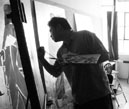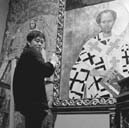SCENES ALONG THE SILK ROAD
“When you're there, it feels like you want to get somewhere else.” Painter Ken Woo's rumination on the vast and forbidding landscape of Inner Mongolia is both eloquent and canny. It echoes a sentiment articulated by a hundred generations of merchants, traders and adventurers traveling eastward along the epochal Silk Road as they passed through the arid Mongolian steppes and on towards the more comfortable and civilized climes of central China.
In the summer of 2002, Woo traveled the ancient highway that, for most of recorded history, was the vital connection between “East” and “West.” The artist had a personal reason to undertake this journey; he was following in the footsteps of his great-grandfather, Woo Quan Sun, a young Shaolin Buddhist monk who migrated from isolated western China, eventually settling in red-hot Shanghai, where he became a rich textile manufacturer and a philanthropist of note. Although he never visited America during his lifetime, the elder Woo funded a Buddhist temple in San Jose, California, and gave a major gift to the Hoover Institute at Stanford University.
The record of the great-grandson’s re-creation of his ancestor journey from Inner Mongolia to the ancient trading city of Xin Jian is contained in a series of two dozen thrilling landscapes and accompanying figure studies of some of the remarkable Buddhist statuary carved out of rock faces and in temples that mark the route of the Silk Road. Woo’s landscapes capture the ochre and umber essence of a dry and dusty land. His figure paintings strive for something even more profound and ineffable.
Woo’s Scenes Along the Silk Road” was displayed at the Beijing Biennial in 2002, where the work was singled out for praise by critics. The reviewer from the Beijing Evening Newspaper noted that "when one sees Woo's paintings, there is an interesting connection between East and West, as well as a feeling akin to a spiritual connection with the gods."
From his artistic loom, Woo strives to weave multi-dimensional tapestry. One aspect of this work is Woo’s attempt to restore the power and immediacy that the stone figures once possessed, but which were lost as a natural result of the distance from its own particular epoch. The artist re-awakens the sleeping power by creating facial features with a modern cast.
Another dimension of Woo's work derives from his ability to represent the subtle interweaving of civilizations and religions that resulted from the traffic in the ideas and symbols that were the inevitable byproduct of the trade in spices, silk, gems and other “real” commodities facilitated by the Silk Road. This 'invisible' traffic may have actually been the Silk Road's important legacy, providing as it did the connective intellectual tissue between eastern and western civilizations and the means by through which each learned and developed.
The tone for Ken Woo’s Silk Road journey is set by a series of inner Mongolian landscapes that capture the vastness of the grasslands that produced Genghis Khan, and the fastness of the Himalayan Mountains, looming omnipotent to the South.
Subtle, yet dramatically rendered, these paintings are reminiscent of some of the arid reaches of the American West captured on canvas in the mid-to-late 19th Century by the Rocky Mountain School, whose members included such renowned painters as Albert Bierstadt, Thomas Hill, George Brewerton, Fredrick Billing, and others. As painted by Ken Woo, Inner Mongolia remains mysterious, yet also becomes more familiar through his renderings. His painting of the pass at Sanxia conveys the ominous feeling that must have suffused the caravans as they headed into a place where bandits might easily be lying in wait. His 18” x 14” painting of Xinjiang could be the backdrop for a Western starring Gregory Peck.
One painting in particular in the series stands out, a 60” x 16” view of the modern Mongolian city of Baotou done in the style of a panoramic camera. There is something at once familiar yet unfamiliar about this place, but the overwhelming sense is one of a vastness that dwarfs human accomplishment.
Monumental Mongolia is a theme that runs throughout the landscape series, and it is also carried over into the eight paintings of the sculpted figures carved in the Fourth through Seventh Century in caves near the Buddhist monasteries and temples that are an omnipresent feature along the Silk Road. To capture their essence, Woo used raw pigments that were natural to the region in combination with tempura. To him, and to the observer, the combination created what Woo calls “an alchemic reaction.”
There is magic as well in the figures themselves; some are silvery, others reddish, but all are suffused with a glowing presence that made them such powerful symbols when, during the Fourth through Seventh Centuries, Buddhism was the world’s most dynamic religion being spread in no small measure by the travelers on the Silk Road.
“The sculptures are dead to us now but once had a power that was immediate,” Woo says, about the artifice he created to recapture the symbolic presence and power of the cave sculptures, as well as what he calls the “stillness, quiet, transcendence and contemplativeness” of the place. Ultimately he decided to render the figures “not as a document of an antiquity,” but rather, as Woo says, “by putting humanity back so that we can related to them as they were related to in their day.”
Woo decided that the way to make the paintings of the sculptures relevant, was to literally, “put on a human face,” painting modern visages that help the viewer relate directly to them. There is another, even deeper, nuance to the renderings; when viewers confront, for example, the largest of the figure paintings, a 3’x5’ rendering of a female figure from the cave at the Mon Gao monastery, there is something almost “Greek” about the woman. Similarly, the man with clasped hands from a cave near Xin Jian presents an appearance that can be said to be “Egyptian.” These depictions are not artistic fancies. Rather, as the artist shows, they comport with the cross-cultural pollination of life, civilization, religion and art along the Silk Road.

